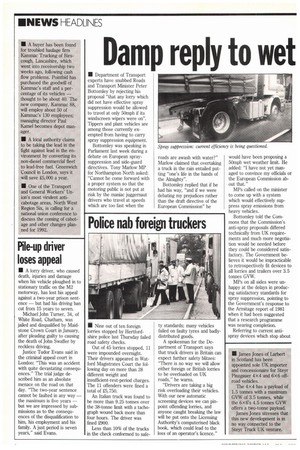Damp reply to wet speed limit
Page 6

Page 7

If you've noticed an error in this article please click here to report it so we can fix it.
• Department of Transport experts have snubbed Roads and Transport Minister Peter Bottomley by rejecting his proposal "that any lorry which did not have effective spray suppression would be allowed to travel at only 50mph if its windscreen wipers were on". Tippers and plant vehicles are among those currently exempted from having to carry spray suppression equipment.
Bottomley was speaking in Parliament last week during a debate on European spraysuppression and side-guard directives. Tony Marlow MP for Northampton North asked: "Cannot he come forward with a proper system so that the motoring public is not put at risk by the maniac juggernaut drivers who travel at speeds which are too fast when the roads are awash with water?" Marlow claimed that overtaking a truck in the rain entailed putting "one's life in the hands of the Almighty".
Bottomley replied that if he had his way, "and if we were debating my prejudices rather than the draft directive of the European Commission" he would have been proposing a 50mph wet weather limit. He added: "I have not yet managed to convince my officials or the European Commission about that."
MIN called on the minister to come up with a system which would effectively suppress spray emissions from heavy vehicles.
Bottomley told the Commons that the Commission's anti-spray proposals differed technically from UK requirements and much more negotiation would be needed before they could be considered satisfactory. The Government believes it would be impracticable to retrospectively fit devices to all lorries and trailers over 3.5 tonnes GVW.
MPs on all sides were unhappy at the delays in producing satisfactory standards for spray suppression, pointing to the Government's response to the Armitage report of 1981 when it had been suggested that a research programme was nearing completion.
Referring to current antispray devices which stop about two thirds of the spray, Tony Lloyd, Labour member for Stretford, said: "A lorry travelling at about 60mph throws up about 60 gallons of water per minute, so about one gallon is still thrown on the car behind every three seconds. That is a lot of water."
Tory back bencher Ivan Lawrence urged the Department of Transport to consider the work being done by Maurice Goddall, who, says Lawrence, has invented an anti-spray device which he claims is up to 98% effective. Bottomley promised to consider Goodall's device but also suggested that motorists should not be quite so keen to overtake trucks: "There is no reason why every domestic car driver should think that it is their duty to overtake every heavy goods vehicle that is travelling along, whether in the wet or the dry."
He did, however, claim that research into whole-vehicle testing and spray suppression was now in its final stages. On the question of sideguards, Bottomley said that EEC regulations allowed round bars for vehicles between 3.5tonnes and 12-tonnes instead of flat rails, but over that weight lorries would have to be fitted with flat side-guards similar to those required by the present UK construction and use regulations.
He acknowledged that the round bars proposed for smaller vehicles offered slightly less protection than the flat rails, but said that a concession on the Government's part was necessary. "Such an agreement is in our interests as it paves the way for international haulage vehicles from Europe being fitted with side-guards similar to those required for United Kingdom-registered vehicles," said Bottomley.
























































































































































